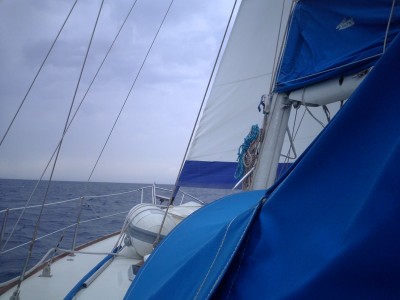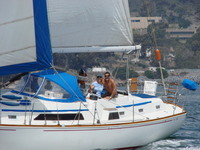
The Adventure Begins
22 May 2011 | Cabo San Lucas, Mexico
20 May 2011 | Chacala Bay, Mexico
19 May 2011 | Puerto Vallarta, Mexico
14 May 2011 | Ipala Bay, Mexico
13 May 2011 | Chamela Bay, Mexico
12 May 2011 | Tenacatita Bay, Mexico
11 May 2011 | Manzanillo, Mexico
06 May 2011 | Caleta de Campos, Mexico
05 May 2011 | Zihuatanejo, Mexico
25 April 2011 | Mexico
20 April 2011 | Mexico
16 April 2011 | Guatemala
13 April 2011 | Nicaragua
09 April 2011 | Nicaragua
02 April 2011 | Costa Rica
01 April 2011 | Costa Rica
30 March 2011 | Costa Rica
29 March 2011 | Costa Rica
28 March 2011 | Costa Rica
23 March 2011 | Costa Rica
Crossing the Gulf of Mexico to United States!
28 May 2009 | Port Charlotte, Florida
Brian

The weather picture for crossing the Gulf was off and on. The weather file (GRIB) comes out every six hours and each weather outlook had us leaving or staying. This time of year we have to really look for tropical storms brewing within the Gulf. We had decided to stay even though we had checked out of Mexico (hanging on anchor), but at 5:30pm we downloaded another file that showed the possible storms forecasted six hours prior not happening and the next week looked bad. We needed about a 4-5 day weather window and it looked good. We quickly made the decision to pull anchor and head out to sea. We left Isla Mujeres at 6:30pm and rounded the island into the Yukon channel under strong SW wind blowing 15-20 knots. The waves were steep in this area so our first night was good sailing & surfing down waves. We weren't directly downwind so the ride was pretty uncomfortable but at least we were sailing at 7-8 knots and didn't need to run the engine.
We shared duties at the helm with 3 hours on and 3 hours off. After sailing for eight months this seems to be the best schedule for us. We watched thunderstorms march across our radar with wind increases, lightning, thunder, and rain. We greeted the new day with reduced wind so we had to start the engine so support the sailing. With our first part of the passage traveling faster than our estimated 6 knots we were going to reach Florida early in the morning of the fourth day.
During our daily routine underway we read, talk, sleep, adjust the autopilot, and generally enjoy our day. You may wonder if we have to steer the boat the whole time while we are underway. Well the only way we can make a four-day passage is with our autopilot. It is electronic and attached to the rudder. All we have to do is set the autopilot to our desired course and it will keep the boat heading in the right direction. It does need course corrections along the way and sometimes in very heavy wind & seas it cannot keep up with the demand so we have to take over, but this only happened twice in 4000 miles of cruising.
The next night was uneventful except being visited by dolphins with a beautiful phosphoresces light show and amazing distant thunderstorm lightening. Luckily, the lightning is off in the distance. It is one of our concerns being hit by lightning. They say that the main thing you need to worry about is the lightning traveling down your mast and blowing through a thru-hull (valve) and sinking the boat and destroying all your electronics. So far, we have been very lucky and not had a lightning strike need us. During the night at watch alone with lightning lighting up the sky I try not to consider these fears.
After motor sailing for a number of hours a thunderstorm send us a welcomed gush front of about 25-30 knots going our way, which really pushed Four Points and helped our arrival time. This only lasted a few hours and we had to crank the diesel engine on again. For the remaining hours of our crossing we had to motor sail because the wind dropped below 7 knots. This was not helping our arrival time and it looked like we were going to get into Port Charlotte later than we hoped.
When I worked out the navigation for this passage I really didn't consider how big Port Charlotte was. In San Diego it takes about one hour from the entrance to get into the harbor. Well, this was a big mistake on my part because to get into Port Charlotte to the place we were going to stay it is 20 miles or 3.5 hours at 6.0 knots. After this realization we needed to get to the entrance of Port Charlotte at not later than 5:00 pm to make it by dark (8:15pm).
While we were passing through the "cut" or entrance to Port Charlotte a large (30) school of huge Tarpon fish were boiling. I've never seen fish so huge, 6 feet long and bigger than me around. Shortly after seeing the fish we came into a large circle of fishing boats because, we found out later, that this is the opening of Tarpon season.
We continued to motor sail in 13 knots of wind in the bay of Port Charlotte. Just after the sunset we arrived at a marina we found on the internet call Fishermen's Village. We were very excited to have made it back to the United States!! We quickly tied up Four Points and headed to the nearest bar on foot. We drank some beer and toasted each other for making our landfall goal. We had a great time!
It's time now to secure Four Points on land for the hurricane season.
We shared duties at the helm with 3 hours on and 3 hours off. After sailing for eight months this seems to be the best schedule for us. We watched thunderstorms march across our radar with wind increases, lightning, thunder, and rain. We greeted the new day with reduced wind so we had to start the engine so support the sailing. With our first part of the passage traveling faster than our estimated 6 knots we were going to reach Florida early in the morning of the fourth day.
During our daily routine underway we read, talk, sleep, adjust the autopilot, and generally enjoy our day. You may wonder if we have to steer the boat the whole time while we are underway. Well the only way we can make a four-day passage is with our autopilot. It is electronic and attached to the rudder. All we have to do is set the autopilot to our desired course and it will keep the boat heading in the right direction. It does need course corrections along the way and sometimes in very heavy wind & seas it cannot keep up with the demand so we have to take over, but this only happened twice in 4000 miles of cruising.
The next night was uneventful except being visited by dolphins with a beautiful phosphoresces light show and amazing distant thunderstorm lightening. Luckily, the lightning is off in the distance. It is one of our concerns being hit by lightning. They say that the main thing you need to worry about is the lightning traveling down your mast and blowing through a thru-hull (valve) and sinking the boat and destroying all your electronics. So far, we have been very lucky and not had a lightning strike need us. During the night at watch alone with lightning lighting up the sky I try not to consider these fears.
After motor sailing for a number of hours a thunderstorm send us a welcomed gush front of about 25-30 knots going our way, which really pushed Four Points and helped our arrival time. This only lasted a few hours and we had to crank the diesel engine on again. For the remaining hours of our crossing we had to motor sail because the wind dropped below 7 knots. This was not helping our arrival time and it looked like we were going to get into Port Charlotte later than we hoped.
When I worked out the navigation for this passage I really didn't consider how big Port Charlotte was. In San Diego it takes about one hour from the entrance to get into the harbor. Well, this was a big mistake on my part because to get into Port Charlotte to the place we were going to stay it is 20 miles or 3.5 hours at 6.0 knots. After this realization we needed to get to the entrance of Port Charlotte at not later than 5:00 pm to make it by dark (8:15pm).
While we were passing through the "cut" or entrance to Port Charlotte a large (30) school of huge Tarpon fish were boiling. I've never seen fish so huge, 6 feet long and bigger than me around. Shortly after seeing the fish we came into a large circle of fishing boats because, we found out later, that this is the opening of Tarpon season.
We continued to motor sail in 13 knots of wind in the bay of Port Charlotte. Just after the sunset we arrived at a marina we found on the internet call Fishermen's Village. We were very excited to have made it back to the United States!! We quickly tied up Four Points and headed to the nearest bar on foot. We drank some beer and toasted each other for making our landfall goal. We had a great time!
It's time now to secure Four Points on land for the hurricane season.
Comments
| Vessel Name: | Four Points |
| Vessel Make/Model: | C&C Landfall 43 |
| Hailing Port: | San Diego |
| Crew: | Brian & Nancy McCluskey |
| About: |
Gallery not available

Who: Brian & Nancy McCluskey
Port: San Diego